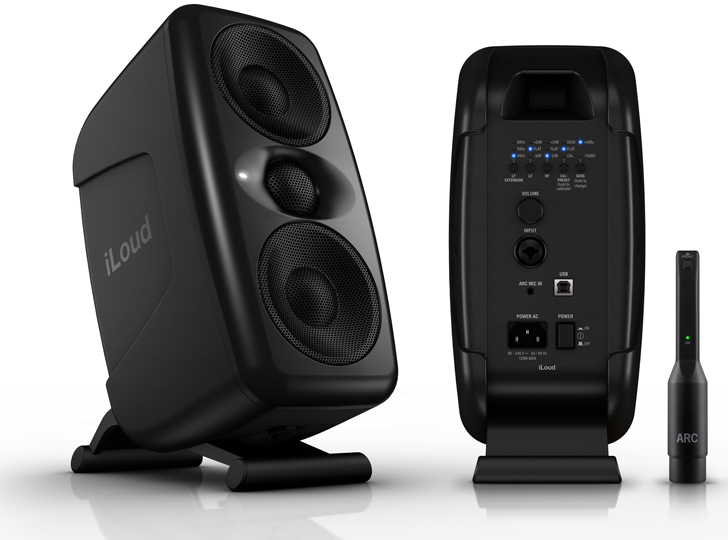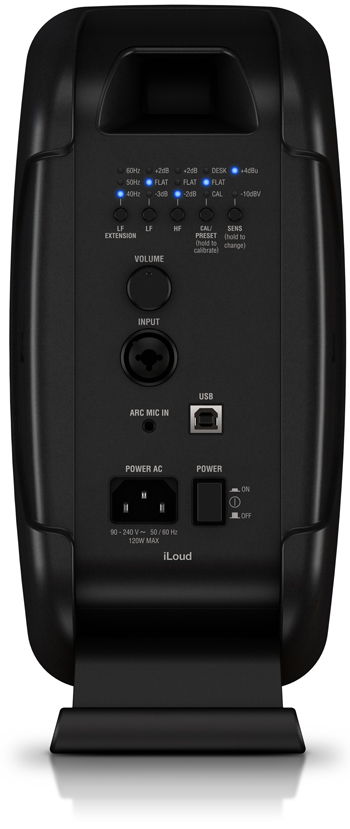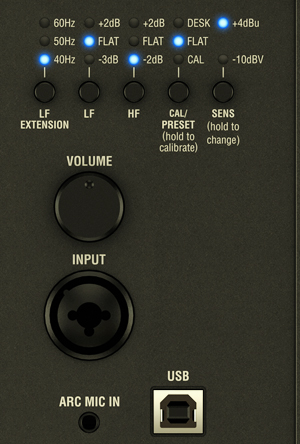
Barry's Mix Magazine Equipment And Software Reviews
Barry's Massive Discography And Engineering Career
Barry's Music Connection Magazine Reviews
Barry's Resolution Magazine Reviews
IK Multimedia iLoud MTM Reference Monitors
By Barry Rudolph
 | IK Multimedia iLoud MTM Reference Monitors with MEM Microphones |
Based in Modena in Northern Italy since 1996, IK Multimedia has the iLoud MTM Reference Monitors which builds on the company's smaller monitor system called the iLoud Micro Monitors introduced in 2016. Designed for small project/home studios, the iLoud MTM Reference Monitors offer accuracy in a smaller footprint.
The self-contained powered iLoud MTM® monitors are DSP-controlled and precision time-aligned; the advanced onboard processing is the product of over twenty years of IK's experience in digital signal processing systems.
The iLoud MTMs use a tuned bass reflex port and are powered by two Class-D power amplifiers. There is a 70-watt (RMS) amp for the two custom-made polypropylene 3.5-inch mid-woofers while a 30-watt (RMS) powers the back-chambered, silk dome tweeter. The tweeter is mounted in the exact center of the front panel with the mid-woofers mounted on either side. Crossover frequency is 3.1kHz using a linear phase variable order filter.
Frequency response is rated at 50Hz to 24kHz +/- 2dB running under calibration (more later); they are capable of 103dB SPL maximum sound pressure at 1-meter from 200Hz up.
The MTMs' rear-facing bass reflex ports are at the top of rear panel; it also doubles as a way to pick them up for portability. They are made from a blend of high impact ABS and PC plastic and measure 264-mm (10.39-inches) tall, 160-mm deep (6.3-inches) by 130-mm (5.12-inches) wide. Each weigh 2.5kg or about 5.5 pounds.
Linear Phase
IK touts that these monitors have flat or linear phase response. They remain phase coherent within +/- 15-degrees measured from 200Hz to 20kHz. Phase integrity and precision is vital for reproducing the exact stereo imaging---panning, delays, the placement of the instruments and vocals within the sound stage that the mixer/producer has intended.
 | iLoud MTM Reference Monitors Back Panel |
The crowded rear panel of MTM tells a lot about these monitors and contains all of its configuration controls. Starting at the top under the reflex port is a row of five push buttons with blue LED indicators. The last state of these buttons/settings is held even with AC power off.
The LF Extension button is a high-pass filter for shaping the low frequencies below: 60Hz, 50Hz (default) or 40Hz. The 100-Hz LF button toggles on/off a shelving EQ through three choices: Flat, +2dB or -3dB positions. The HF button is for selecting Flat, +2dB or -3dB from an 8kHz shelving filter. All filters are 2nd order.
A fourth button is called CAL/Preset and it's dual purpose. You may cycle through: Flat (response), a Desk curve designed to ameliorate the acoustic boundary effects of desktop monitor placement, and CAL for setting up and activating an internally stored calibration curve. This is the same technology used in IK's ARC 2.5 Advanced Room Control software. However, unlike that software system which stores any number of correction curves for any number of monitors, this version stores a single curve inside of each monitor.
These monitors are for desktop use--up close nearfield placement. The Desk curve is shown in the manual; it has a -4dB bell-shaped notch at 100Hz and also a 1dB boost at 1.8kHz. If you hold down the CAL/Preset button for two seconds, the monitor enters the calibration mode using the included phantom-powered ARC™ MEMS measurement microphone now used in the latest version of ARC. A special cable with an XLR on one end and a mini TS on the other connects the microphone to the speaker using a rear panel jack.
The rear panel finishes with a Sensitivity button to toggle between +4dbu and -10dBv operating range, a volume control, XLR Combo audio input jack, on/off switch, an IEC AC power connector, plus a USB connector for future firmware revisions downloads.
Options And Setup
The IK Multimedia iLoud MTM Reference Monitors are sold in two ways: one monitor at a time or in pairs. Either way they include one ARC reference measurement MEMS microphone, clip and cable. There are also two different bases included for setting the MTMs up either vertically (as I preferred) or horizontally if you want to place them on monitor stands, shelves, or atop other monitor speakers. They also have threaded adapter recessed in the bottom of the MTM for mounting them directly atop a standard microphone stand.
The vertical setup of the MTM worked well on my minimal desktop space. I set them up on either side of my 29-inch DAW computer's video monitor. The manual goes over using the imaginary "Magic Equilateral Triangle" speaker positioning method to properly set them up.
I had the two MTMs 32-inches apart on either side of my 29-inch DAW screen. The listening position was in front of my desk just where I always sit to mix music. I angled them up at 20-degrees (max) and locked them in to aim them right at my ears. I had the top woofer aimed a little over my head as I found that was better when an artist or the producer was standing behind me and listening.
I used output 2 of my Cranesong Avocet II monitor controller and switched the MTM's to +4dBU and turned down the rear panel volume control to (more or less) match the volume level of my other studio monitors when switching between them using the Avocet.
I learned that IK auditioned several A/D/D/A clocking chip combinations and decided on an AKM's AK4621 chip set running at 48kHz/24-bit to convert incoming analog audio into digital for processing for the crossovers, filtering, time alignment, equalization, dynamics control and calibration. The processed digital audio is then converted back into analog for driving the two amplifiers. I experience no problem with latency.
Calibration
After I set up the MEMS microphone as directed in the manual, I held the CAL/Preset button down for two seconds. The MTM begins the calibration procedure by sweeping a 20 to 20kHz tone. It takes about 20-seconds to run the calibration routine on each speaker separately and I liked the "feedback" of blinking colored LEDs as confirmation that the sweeps were successful. Also thoughtful is that any rear panel EQ/filter settings you (inadvertently) had set are not in play during calibration. I used the mic set in the same place to sweep both speakers individually. If for some reason, you swap speakers or reposition them, you would re-calibrate them.
 | Close Up Rear Panel Controls |
After this process I started playing all kinds of different music sources and I was immediately impressed. Solid bass, excellent stereo imaging that seem to "point" out phase anomalies instantly! Such has phase issues that happen when using multiple microphones on the same source. I heard tom-tom fill in a drum kit that came from behind me!
A quick comparison to my mains revealed that MTMs are slightly boxy sounding--an upper bass presence and that is my experience with small box speakers like Yamaha NS10ms. I tried the +2dB setting on the HF section to try and help that but flat sounded better. I'd like to try the calibration setting and the Desk mode at the same time but that is not possible. I think the MTMs presented a more forward mid-range sound and that is what I wanted--a little more focus on those frequencies.
I liked the MTMs with calibration running as it had better bass--I felt my desktop vibrate and the air pumping out of the rear port! Using the Desk curve, I switched in the 40Hz extension and the -3dB LF setting. But I am still experimenting with this configuration; it is an ongoing and continuing process for me, and I'm sure I'll settle in with more listening time.
The Main Reason
My main reason for monitors this close is that, with the mix audio only about 32-inches from each of my ears, the sound is very present and in my face. It is somewhat like wearing headphones except with the inter-aural mixing of the left and right monitors which you don't get with phones. So the MTMs are a sonic microscope for both phase integrity and mid-range that I look for in a second pair of small monitors to reference to my mains.
I was also impressed by the amount of bass these speakers deliver despite their diminutive size. The bass is solid and not floppy, loose and indistinct. My control room is an acoustically treated space and well bass trapped so that would have an effect here and I used to mixing in here.
Loving Them!
I've been looking for full range and small monitors I can put on my desktop and not block the sound coming from my mains behind them. The compact iLoud MTM Reference Monitors are working for me with their super clear and powerful sound. Highly recommended!
|
|
|
|
|
|